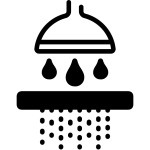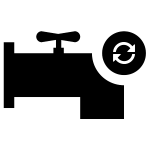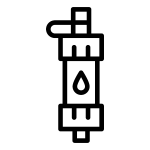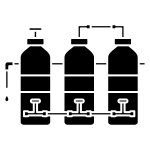Are you tired of those stubborn white chalky stains ruining the shine of your faucets and taps? That’s limescale, a common nuisance caused by hard water—and it not only looks bad, but it can also reduce the lifespan and performance of your faucets. If you’re searching for how to get rid of limescale on faucet, you’ve come to the right place.
In this comprehensive blog post, we will explain:
- What is limescale?
- What causes it?
- Why you need to remove it regularly
- The best methods to get rid of limescale on faucets (naturally and chemically)
- How to prevent it in the future with Cuoll’s premium water filters and purifiers
Let’s dive in and bring back that shine to your bathroom and kitchen faucets!
What Is Limescale?
Limescale is a hard, chalky white deposit made up of calcium carbonate (CaCO₃) that builds up in areas with hard water. It often appears on faucets, showerheads, sinks, kettles, and inside water pipes.
Common Signs of Limescale Buildup:
- White or grayish spots on taps and fixtures
- Reduced water flow
- Difficulty in turning faucet handles
- Appliance damage (like kettles and water heaters)
- Soap not lathering properly
Limescale is particularly common in homes that do not use a water filter or water softener.
What Causes Limescale on Faucets?
The main reason behind limescale formation is hard water. Hard water contains high levels of minerals like calcium and magnesium, which settle on surfaces as water evaporates.
When water flows through your pipes, the minerals stick to surfaces—especially around metal components like faucet nozzles, spouts, and valves. Over time, these minerals accumulate and harden, forming limescale.
Why You Should Remove Limescale ASAP
Ignoring limescale buildup can lead to:
- Clogged aerators and poor water flow
- Corrosion of metal parts inside faucets
- Stains on bathroom or kitchen fittings
- Shorter lifespan of appliances like dishwashers, washing machines, and heaters
- Higher utility bills due to inefficiencies
That’s why it’s essential to not only remove limescale from faucets but also to prevent it using effective solutions like water filtration systems, which we proudly offer at Cuoll.
How to Get Rid of Limescale on Faucet – Step-by-Step Solutions
1. White Vinegar Method (Natural & Safe)
Best for: Light to moderate limescale buildup
Materials:
- White vinegar
- Old toothbrush
- Cloth or paper towel
- Rubber band or zip tie
- Plastic bag
Instructions:
- Fill a plastic bag with white vinegar.
- Place the bag over the faucet so that the spout is submerged in vinegar.
- Secure the bag with a rubber band and let it soak for 1–2 hours.
- Remove the bag, scrub the faucet gently with a toothbrush.
- Rinse with warm water and wipe dry.
Why it works: Vinegar contains acetic acid, which dissolves calcium carbonate deposits effectively.
2. Baking Soda Paste
Best for: Tougher stains or awkward faucet areas
Instructions:
- Mix baking soda with a small amount of water to form a thick paste.
- Apply the paste directly to the limescale-affected areas.
- Let it sit for 15–20 minutes.
- Scrub with a toothbrush or sponge.
- Rinse with warm water.
Bonus Tip: Combine vinegar and baking soda for a foaming reaction that boosts cleaning power.
3. Commercial Limescale Removers
Best for: Heavy limescale buildup or professional-grade cleaning
Some powerful descaling products are made specifically to remove mineral deposits from metal surfaces.
Tips for using:
- Follow manufacturer instructions carefully
- Wear gloves and ensure ventilation
- Avoid prolonged contact with chrome finishes
Popular brands include Cillit Bang, Viakal, and CLR. However, make sure they are safe for your faucet’s material.
4. Lemon Juice Method
Best for: Mild limescale and adding a fresh scent
Lemon juice contains citric acid, which works similarly to vinegar.
Instructions:
- Cut a lemon in half and rub it directly on the faucet.
- Let it sit for 10–15 minutes.
- Scrub and rinse.
This method is not only effective but also adds shine and a pleasant aroma to your bathroom or kitchen.
How to Clean Faucet Aerator Blocked by Limescale
The aerator is the screen at the faucet’s tip where water flows out. It often gets clogged with limescale.
Steps:
- Unscrew the aerator from the faucet using pliers (use a cloth to avoid scratches).
- Soak it in vinegar for an hour.
- Scrub the screen with an old toothbrush.
- Rinse and screw it back on.
Tip: Do this once a month to ensure smooth water flow.
How to Prevent Limescale on Faucet – The Long-Term Solution
Cleaning is helpful, but prevention is the real solution. Here’s how to avoid limescale from forming again.
1. Install a High-Quality Water Filter
At Cuoll, we offer premium water filters that effectively reduce calcium, magnesium, and other minerals that cause limescale.
Our top picks:
- CUOLL Faucet Water Filter – Easy to install, compact design
- CUOLL Whole House Water Filtration System – Treats all water entering your home
- CUOLL Bath Ball Filter – White Pro – Perfect for showers and bath taps
A water filter improves:
- Faucet lifespan
- Water flow
- Skin and hair health
- Appliance durability
2. Use a Water Softener System
If you live in a hard water area, consider installing a whole-house water softener that removes calcium and magnesium ions completely.
3. Wipe Faucets Dry After Use
Limescale forms as water evaporates. By wiping your faucet dry after use, you prevent mineral buildup.
4. Regular Maintenance
Make it a habit to:
- Clean faucets weekly with vinegar
- Remove and clean aerators monthly
- Inspect for early signs of buildup
Cuoll – Your Partner in a Limescale-Free Home
At Cuoll, we are passionate about helping you live cleaner and better. Our range of water filters, purifiers, and bathtub products is carefully curated to protect your home from water-related damage, including limescale.
Why choose Cuoll?
- Trusted, durable, and affordable products
- Easy installation with minimal tools
- Designed for Bangladeshi and international households
- Fast delivery and friendly customer service
Conclusion: Keep Your Faucets Limescale-Free with Ease
Knowing how to get rid of limescale on faucet is the first step toward maintaining a healthy and clean kitchen or bathroom. From using vinegar and baking soda to installing a Cuoll water filter, there are many easy and effective ways to fight limescale.
Key Takeaways:
- Limescale is caused by hard water and appears as white chalky deposits.
- Natural cleaners like vinegar and lemon juice work well for regular cleaning.
- For heavy buildup, commercial descalers or baking soda paste are effective.
- Long-term prevention is best achieved by using Cuoll’s water filtration systems.
Ready to say goodbye to limescale for good?
👉 Explore Cuoll’s faucet filters, water purifiers, and bath filtration systems now and enjoy a limescale-free home today!







